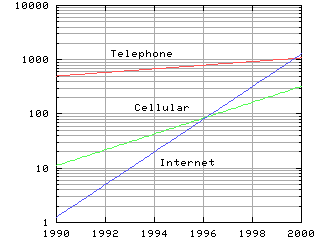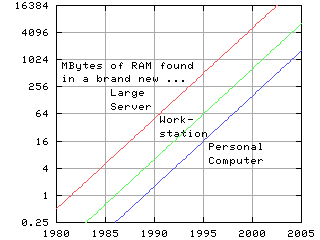Aronsson @ Lysator . LiU . SE
Trends in Information Technology
presented by Lars
Aronsson
Keeping up with Exponential Growth
- Ibland hör man att utvecklingen av datortekniken går allt
snabbare, och snart hänger ingen med. Det är inte riktigt sant.
Många värden ökar exponentiellt, med jämn takt. Det betyder att de
tar en viss tid att fördubbla sig, ungefär som ett kapital med ränta
på ränta. Räntan är den årliga tillväxttakten. Om vi ritar ett
tidsdiagram där den vertikala axeln är logaritmisk, får vi raka streck.
- It is sometimes claimed that the development of computers is ever
accelerating, and we will all get behind. That is not quite true.
Many values increase exponentially, at a constant rate. This means
they take a certain time to double, just like a bank account. The
interest is the growth rate. If we draw a time diagram with a
logarithmic vertical scale, we will see straight lines.
Where is the Information Superhighway?

Figure 1. Million Network Users World-Wide
- I augusti 1995 fanns det 60 miljoner människor som använde
mobiltelefon. Denna siffra växer med 40% årligen. Samtidigt fanns det
40 miljoner människor som använde Internet, och den siffran växer med
100% varje år. Antalet vanliga telefonabonnemang i världen förväntas
fördubblas från 1990 till 2000, upp till 1 miljard. Det betyder en
årlig ökning om mindre än 8 % i medeltal. (Källa: Ericsson)
- In August 1995, the world's cellular telephone systems had a total
of 60 million subscribers. This number has seen a 40 % annual
increase over the last 5 years. At the same time, 40 million people
have access to the Internet, increasing by 100 % annually. Between
1990 and 2000, the number of telephone exchange lines in the global
network is expected to double to 1 billion. The annual growth
averages less than 8 %. (Source: Ericsson)
- De företag som dominerar mobiltelefonmarknaden är svenska Ericsson, finska Nokia, och amerikanska Motorola. Värdet på Ericssons
aktie har nära nog fördubblats på tre kvartal på Stockholms fondbörs. Mobil- och
telefonbolag är sammanslutna i ITU, den Internationella Teleunionen. Företag som satsar stort på
Internet är Sun Microsystems Inc,
Cisco Systems Inc och Netscape Inc.
Internet-operatörer och andra interesserade är sammanslutna i Internet Society.
- Companies that dominate the cellular market are Swedish Ericsson, Finnish Nokia, and American Motorola. The value of Ericsson
shares on the Stockholm Stock
Exchange has nearly doubled in the last three quarters. Cellular
and telephone network operators are organized in ITU, the International Telecommunications Union.
Companies with a strong position on the Internet market are Sun Microsystems Inc, Cisco Systems Inc, and Netscape Inc. Internet operators
and interested parties are organized in the Internet Society.
Memories
- Minneskapslar (RAM) är en väsentlig komponent i alla datorer, och
har haft samma principiella konstruktion sedan 1970, då de första
innehöll 1 kbit. Sedan dess har kapslarnas storlek varit i stort sett
konstant, men mängden minne per kapsel har i princip dubblats var 18:e
månad. Tillfälliga avvikelser (jordbävning i Kobe) stör inte mönstret
på längre sikt.
- Dynamic Random Access Memory chips (DRAM) are important components
of all computers, and have been continuously refined since 1970, when
the first ones contained 1 kbit. Since then, the physical size of the
chips has been about the same, but the amount of memory per chip has
doubled every 18 months. Temporary fluctuations (earth quake in Kobe)
do not disturb the pattern over a longer time period.

Figure 2. Megabytes of RAM Found in Brand New Computers
- Din persondator är ungefär lika stor som den förra du hade och som
nästa du kommer att köpa. De kommer att innehålla ungefär lika många
minneskapslar. Skillnaden ligger i hur många bits och bytes som ryms
i kapslarna. Efter tre år kommer en ny dator att innehålla fyra
gånger så mycket internminne.
- Your personal computer is about the same size as the last one you
had, and the same as the next one you will buy. They will contain
about the same number of memory chips. The difference is the number
of bits and bytes on those chips. After three years, a new computer
will have about four times more internal memory.
Who needs this?
- Ett mötesprotokoll eller ett långt brev innehåller i
storleksordningen 10.000 nedslag (bokstäver, tecken och mellanslag). I
en enkel ordbehandlare blir detta 10 kilobyte. De första
persondatorerna i början av 1980-talet hade 64 kilobyte RAM, så både
ordbehandlingsprogrammet och texten fick plats. Då var det svårt att
föreställa sig vad man skulle med 16 megabyte till. Spelen såg ut som
Masken eller Breakout.
- The minutes from a meeting or a long letter contains about 10,000
printable characters. In a simple word processor this means 10
kilobytes. The first personal computers in the early 1980s had 64
kilobytes of RAM, which fitted both the word processor software and
the text. It was hard to imagine who would need 16 megabytes.
Computer games looked like Snake or Breakout.
- Idag följer en CD-spelare och stereohögtalare med när man köper en
ny persondator. Man kan besöka museiutställningar och slå i
uppslagsböcker med hjälp av persondatorn. Ordbehandlaren kan välja
mellan hundratals teckensnitt och man kan montera in bilder i
mötesprotokollet. Spelen har rörlig tredimensionell grafik och
ljudeffekter.
- Today many personal computers come with a CD-ROM player and a
stereo sound. You can visit museums and search an encyclopedia with
your personal computer. The word processor can select hundreds of
fonts and you can import images in your meeting minutes. Games have
moving 3D graphics and sound effects.
- År 2004 förväntas nya persondatorer att ha 1 gigabyte minne. Idag
är det få av dem som ens har så mycket disk. Vi kommer inte att
redigera mötesprotokoll som motsvarar tusen romaner och vi kommer inte
att besöka tiotals muséer på en kväll. Men det kommer att vara
naturligt att ta in TV-nyheterna på datorskärmen. Datorn har kanske
en stor projektorskärm och hela Hollywoodfilmer lagrade på disken.
Internet har för länge sedan vuxit om telefonnätet, som framgår av
figur 1, så det kommer att vara lättare att nå en person genom datorn
än med en vanlig gammal telefon.
- In the year 2004, new personal computers are expected to have 1
gigabyte of internal memory. Today, few of them even have that much
disk. We will not edit meeting minutes as thick as a thousand novels
and we will not visit tens of museums in one night. But it will be
natural to open a window and watch the TV news. Computers might have
large projector screens with entire Hollywood movies stored on disk.
The Internet will long since have passed the telephone network, as
shown by figure 1, so you are more likely to reach someone through
your computer than through an old-style phone.


